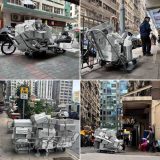
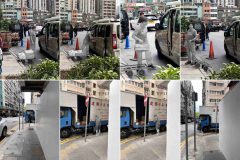
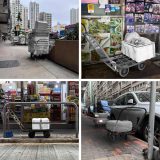
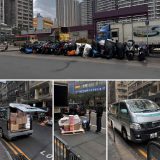
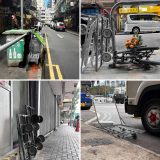
Transcript
Zhao Meijing: With the urbanization of Hong Kong, many things are leaving us. This time, we focus on the trolleys at the bottom of Mandarin's New Village.
The disappearance of the trolley is not only a sign that this object is leaving us but also a sign of the change in the development mode of Hong Kong's small commodity economy and the transformation of people's urban planning concept. These two aspects are precisely the reasons for the disappearance of the trolley.
Wang Tianyi: The modularized and industrialized commodity economy has replaced the individual economy. Large-scale chains do not need the workforce to transport goods.
From the perspective of urban planning, geographically, firstly, Man Wah Buildings is situated at the "gateway to West Kowloon"; secondly, it is located just three minutes away from the Austin MTR station and bus stops; and the reclamation in the 1990s has weakened its function as a sea view residential estate, reinforcing its relationship with the surrounding high-end residential buildings. In addition, the growing spiritual needs of residents, Hong Kong's tourism industry, and its prime location have combined to transform it from a single-function residential area to a mixed-use development. These change processes are reflected in residents, news, and official documents.
Zhao Meijing: The history of Hong Kong's trolleys can be traced back to the early 20th century; trolleys were one of the main means of transportation. Workers usually use trolleys to transport goods from commercial areas to shops, restaurants, and residential places.
With the development of modernization, the freight mode in Hong Kong has changed, and large trucks and mechanized equipment have gradually replaced trolleys. Nevertheless, trolleys still exist in specific environments like narrow laneways, pedestrian streets, and densely populated areas. Cleaners usually use trolleys to transport garbage and clean utensils.
Wang Tianyi: The purpose of the trolley service is to provide convenient transportation. Many vendors use trolleys to deliver all kinds of goods on the narrow sidewalks that cars can't enter, providing a fast and flexible cargo transportation solution.
In addition, the trolley also plays the role of cheap labor. Workers usually earn income by pushing small carts, an employment opportunity for some low-income people.
Zhao Meijing: When the trolleys no longer exist in Hong Kong, it may affect the following groups.
Small-scale vendors: Many small-scale vendors rely on trolleys to transport goods from suppliers to points of sale. If trolleys no longer exist, they may need to look for other expensive modes of transportation, such as bicycles or walking. Furthermore, trolleys are usually driven by low-income workers who rely on this work to earn income. If the trolley no longer exists, these workers may lose job opportunities and need to find other jobs or face the risk of unemployment.
Wang Tianyi: For the affected groups, they may have different attitudes:
Vendors may feel inconvenienced and need clarification about the disappearance of trolleys. They may look for other alternatives but also face higher operating costs and transportation problems. Meanwhile, low-income workers may be worried and disappointed with the disappearance of the trolley because it is an important way for them to earn income. They may need to look for other employment opportunities.
However, some benefits exist, such as allowing pedestrians and vehicles to move more freely within the area. At the same time, when the trolley is driven on busy streets, it may increase the potential risk to the Man Wah Building and its surrounding environment, such as collision or damage to the building. Eliminating carts reduces these safety risks and protects the building.
Of course, it can also improve the quality of the entire new district planning. Create a cleaner, more vibrant environment by cleaning up streets and pedestrian areas. This helps to attract more investment and development opportunities, raising the profile and attractiveness of the entire region.
Zhao Meijing: The community is implementing practical and effective actions at large for the significant transformation of the urban spatial functions behind the disappearance of trolleys. Existing vendors are working with larger suppliers to shift from trolleys to trucks. With the government's help in relocating their stores to minimize disruptions to their operations, the government and urban planning authorities have introduced policies and asked residents for their opinions to try to gain their cooperation.
The disappearance of the traditional Hong Kong lifestyle represented by the trolleys is certainly regrettable. Still, the new buildings that will rise on the same land are even more exciting and anticipated.
Zhao Meijing 3036126991
Wang ianyi 3036264688
Reference
Seng, M. feng, Leung, D., & Dewolf, C. (2023, April 12). Man Wah Sun Chuen. Wikipedia. https://en.wikipedia.org/wiki/Man_Wah_Sun_Chuen